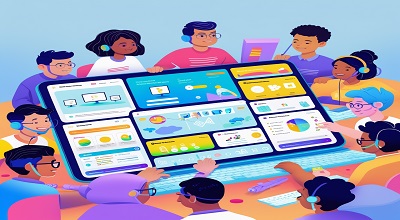Online Tools for Special Needs
The world of education is constantly evolving, and with the rise of technology, new opportunities have emerged to support students with special needs. Online tools and resources have become a lifeline for educators, parents, and students, offering innovative ways to enhance learning, communication, and skill development. This article explores the latest educational online tools designed specifically for special needs students, their benefits, and how they are transforming the educational landscape.
Introduction to Special Needs Education and Technology
Special needs education focuses on providing tailored learning experiences for students with disabilities, including autism, ADHD, dyslexia, and other cognitive, physical, or emotional challenges. Technology has played a pivotal role in bridging the gap between traditional teaching methods and the unique needs of these students. From assistive technologies to interactive apps.
The digital age has opened up new possibilities for inclusive education.Online tools for special needs students are designed to address specific challenges, such as communication barriers, sensory processing difficulties, and learning disabilities. These tools not only enhance academic performance but also foster independence, social skills, and confidence.
The Role of Online Tools in Special Needs Education
Online tools have revolutionized special education by offering:
- Accessibility: Tools like screen readers, text-to-speech software, and customizable interfaces make learning accessible to students with visual, auditory, or motor impairments.
- Personalization: Many tools allow educators and parents to tailor content to the individual needs of the student, ensuring a more effective learning experience.
- Engagement: Interactive apps and games make learning fun and engaging, helping students stay motivated and focused.
- Skill Development: Tools designed for special needs students often focus on building life skills, communication abilities, and social interactions.

Latest Online Tools for Special Needs Students
1. Assistive Communication Tools
Assistive communication tools are essential for students with speech or language impairments. These tools help non-verbal or minimally verbal students express themselves effectively.
- Proloquo2Go: A popular app that supports non-speaking children by helping them develop language skills. It features a customizable interface, allowing users to personalize the app to meet their unique needs.
- Speechify: This tool converts text into speech, making it easier for students with reading difficulties to access written content.
2. Interactive Learning Platforms
Interactive platforms provide engaging and inclusive learning experiences for students with special needs.
- HelpKidzLearn: This platform offers accessible learning tools and COPPA-compliant software, ensuring a safe and engaging environment for special needs children.
- Do2Learn: Known for its picture communication cards, songs, games, and learning activities, this tool is ideal for students with autism, Asperger’s, and other disabilities.
3. Reading and Writing Aids
Students with dyslexia or other learning disabilities often struggle with reading and writing. Online tools can help bridge this gap.
- Read&Write: A literacy support tool that offers features like text-to-speech, word prediction, and a dictionary to assist students with reading and writing challenges.
- Co:Writer: This app provides word prediction and speech recognition to help students with writing difficulties.
4. Sensory-Friendly Tools
Sensory-friendly tools are designed to support students with sensory processing disorders by creating a calming and focused learning environment.
- Calm Counter: A visual and audio tool that helps students manage their emotions and reduce anxiety.
- Sensory App House: Offers a range of apps designed to provide sensory input and improve focus.
5. Educational Games and Apps
Games and apps make learning enjoyable while addressing specific educational goals.
- Endless Reader: An app that teaches sight words and vocabulary through interactive animations and games.
- ABCmouse: A comprehensive learning platform that covers various subjects and is adaptable for students with special needs.
6. Tools for Social and Emotional Learning
Social and emotional learning (SEL) is crucial for students with special needs to develop interpersonal skills and emotional regulation.
- Zones of Regulation: An app that teaches students how to identify and manage their emotions.
- Social Express: A tool that helps students develop social skills through interactive lessons and scenarios.

Virtual Reality (VR) and Augmented Reality (AR)
VR and AR technologies are emerging as powerful tools for special education, offering immersive and interactive learning experiences.
- Google Expeditions: Allows students to explore virtual environments, enhancing their understanding of complex concepts.
- AutiSpark: A VR app designed specifically for children with autism, focusing on social skills and sensory integration.
Benefits of Online Tools for Special Needs Students
1. Enhanced Learning Outcomes
Online tools provide personalized and adaptive learning experiences, helping students achieve their academic goals more effectively.
2. Improved Communication
Assistive communication tools enable students to express themselves, fostering better relationships with peers, teachers, and family members.
3. Increased Independence
By using tools that support daily tasks and learning, students gain confidence and independence in their abilities.
4. Support for Educators and Parents
Online tools offer valuable insights into student progress, enabling educators and parents to make informed decisions about their learning plans.
Challenges and Considerations
While online tools offer numerous benefits, there are challenges to consider:
- Accessibility: Not all students have access to the necessary devices or internet connectivity.
- Training: Educators and parents may require training to effectively use these tools.
- Cost: Some tools can be expensive, limiting their availability to certain schools or families.
- Customization: Tools must be adaptable to meet the diverse needs of students with varying disabilities.
Future Trends in Special Needs Education Technology
The future of special needs education technology is promising, with advancements in artificial intelligence, machine learning, and wearable devices. These innovations will further enhance the personalization and effectiveness of online tools, making education more inclusive and accessible for all students.

FAQs
1. What are online tools for special needs students?
Online tools for special needs students are digital resources, apps, and platforms designed to support their unique learning, communication, and developmental needs.
2. How do assistive communication tools work?
Assistive communication tools, like Proloquo2Go, use symbols, text, and speech to help non-verbal or minimally verbal students communicate effectively.
3. Are these tools suitable for all disabilities?
While many tools are versatile, some are designed for specific disabilities. It’s essential to choose tools that align with the student’s individual needs.
4. Can parents use these tools at home?
Yes, many online tools are designed for both classroom and home use, allowing parents to support their child’s learning and development.
5. Are there free tools available for special needs students?
Yes, several free tools and apps, such as Google Classroom and Khan Academy, offer resources for special needs students. However, some advanced tools may require a subscription.
6. How can educators integrate these tools into their teaching?
Educators can integrate online tools by incorporating them into lesson plans, using them for assessments, and providing training to students on how to use them effectively.
7. What is the future of technology in special needs education?
The future includes advancements in AI, VR, and AR, which will offer more personalized and immersive learning experiences for special needs students.
Conclusion
Educational online tools for special needs students are transforming the way we approach inclusive education. By addressing the unique challenges faced by these students, these tools empower them to reach their full potential. As technology continues to evolve, the possibilities for special needs education are limitless, paving the way for a more inclusive and equitable future.
